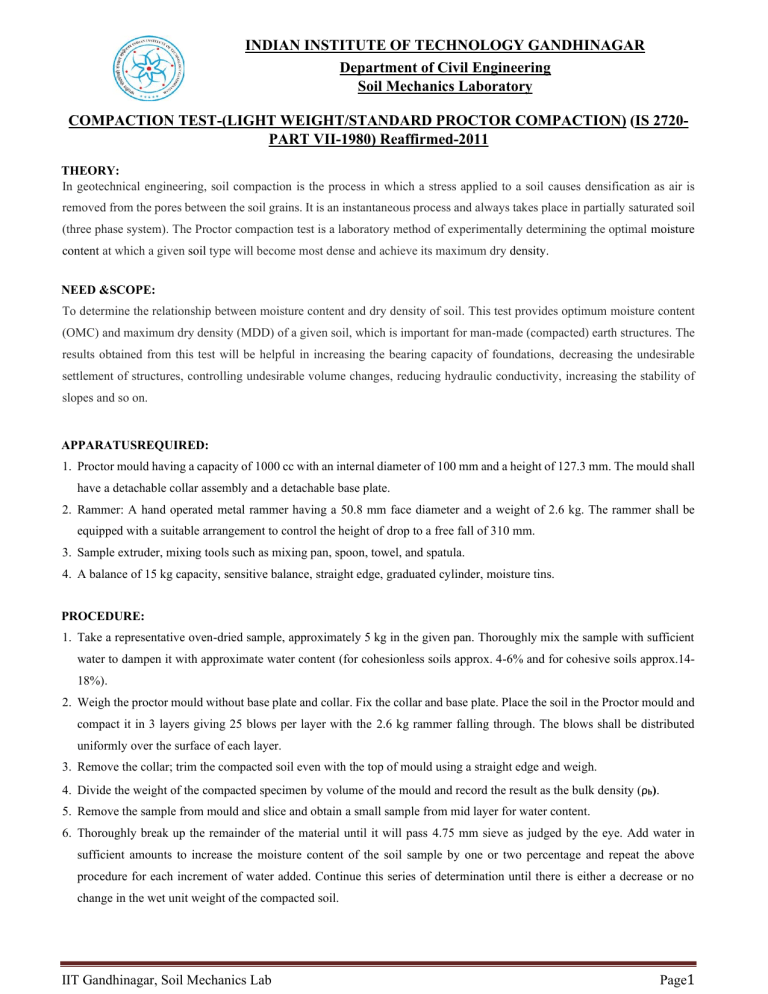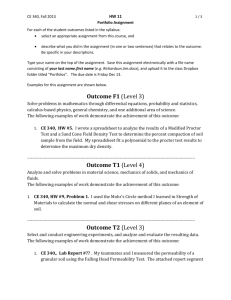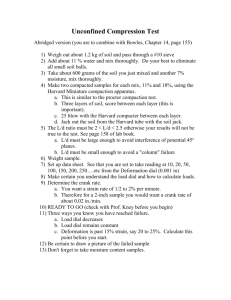
INDIAN INSTITUTE OF TECHNOLOGY GANDHINAGAR Department of Civil Engineering Soil Mechanics Laboratory COMPACTION TEST-(LIGHT WEIGHT/STANDARD PROCTOR COMPACTION) (IS 2720PART VII-1980) Reaffirmed-2011 THEORY: In geotechnical engineering, soil compaction is the process in which a stress applied to a soil causes densification as air is removed from the pores between the soil grains. It is an instantaneous process and always takes place in partially saturated soil (three phase system). The Proctor compaction test is a laboratory method of experimentally determining the optimal moisture content at which a given soil type will become most dense and achieve its maximum dry density. NEED &SCOPE: To determine the relationship between moisture content and dry density of soil. This test provides optimum moisture content (OMC) and maximum dry density (MDD) of a given soil, which is important for man-made (compacted) earth structures. The results obtained from this test will be helpful in increasing the bearing capacity of foundations, decreasing the undesirable settlement of structures, controlling undesirable volume changes, reducing hydraulic conductivity, increasing the stability of slopes and so on. APPARATUSREQUIRED: 1. Proctor mould having a capacity of 1000 cc with an internal diameter of 100 mm and a height of 127.3 mm. The mould shall have a detachable collar assembly and a detachable base plate. 2. Rammer: A hand operated metal rammer having a 50.8 mm face diameter and a weight of 2.6 kg. The rammer shall be equipped with a suitable arrangement to control the height of drop to a free fall of 310 mm. 3. Sample extruder, mixing tools such as mixing pan, spoon, towel, and spatula. 4. A balance of 15 kg capacity, sensitive balance, straight edge, graduated cylinder, moisture tins. PROCEDURE: 1. Take a representative oven-dried sample, approximately 5 kg in the given pan. Thoroughly mix the sample with sufficient water to dampen it with approximate water content (for cohesionless soils approx. 4-6% and for cohesive soils approx.1418%). 2. Weigh the proctor mould without base plate and collar. Fix the collar and base plate. Place the soil in the Proctor mould and compact it in 3 layers giving 25 blows per layer with the 2.6 kg rammer falling through. The blows shall be distributed uniformly over the surface of each layer. 3. Remove the collar; trim the compacted soil even with the top of mould using a straight edge and weigh. 4. Divide the weight of the compacted specimen by volume of the mould and record the result as the bulk density (ρb). 5. Remove the sample from mould and slice and obtain a small sample from mid layer for water content. 6. Thoroughly break up the remainder of the material until it will pass 4.75 mm sieve as judged by the eye. Add water in sufficient amounts to increase the moisture content of the soil sample by one or two percentage and repeat the above procedure for each increment of water added. Continue this series of determination until there is either a decrease or no change in the wet unit weight of the compacted soil. IIT Gandhinagar, Soil Mechanics Lab Page1 INDIAN INSTITUTE OF TECHNOLOGY GANDHINAGAR Department of Civil Engineering Soil Mechanics Laboratory OBSERVATIONS: Mould Diameter ………... cm, Density Height ………… cm, Volume ………. cc, Determination No. 1 2 3 Weight ………… gm 4 5 6 Weight of water added, Ww (gm) Weight of mould + compacted soil (gm) Weight of compacted soil, W (gm) Average moisture content, w % Bulk density (gm /cc) = W / (Mould volume) Dry density (gm/cc) = Bulk density/(1+w) Water content Container No. Wt. of container (gm) = Wc Wt. Of container + wet soil (gm) = W1 Wt. Of container + dry soil (gm) = W2 Water content, w = (W2–W1)/(W1–Wc) x 100% Note: Plot dry density vs. moisture content and find out the max dry density and optimum moisture for the soil. GENERAL REMARKS: • The peak point of the compaction curve: The peak point of the compaction curve is the point with the maximum dry density ρd max. Corresponding to the maximum dry density ρd max is a water content known as the optimum water content (also known as the optimum moisture content, OMC). Note that the maximum dry density is only a maximum for a specific compactive effort and method of compaction. This does not necessarily reflect the maximum dry density that can be obtained in the field. • Zero air voids curve: The curve represents the fully saturated condition (S = 100 %). (It is a hypothetical situation and cannot be reached by compaction).


